Sixties
City presents
a wide-ranging series of
articles on all aspects of the Sixties, penned by the creator of the iconic
60s music paper Mersey
Beat
|
Sixties
City presents
a wide-ranging series of
articles on all aspects of the Sixties, penned by the creator of the iconic
60s music paper Mersey
Beat
|
||||||
|
 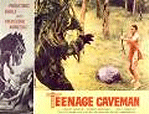  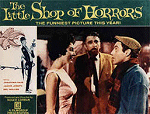 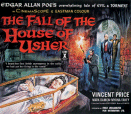 |
The horror stories of Edgar Allen Poe were the inspiration for a series of stylish colour films produced by cult director Roger Corman, a Hollywood phenomenon, a producer/director who literally churned out movies on miniscule budgets within a matter of days. His output was incredible and his low-budget productions included western, gangster, science-fiction, rock, war and biker movies with titles such as ‘She Gods of Shark Reef’, ‘Teenage Caveman’, ‘The Viking Women and the Sea Serpent’ and ‘The Little Shop of Horrors'.His most notable series of films, which have become something of a cult, are his Edgar Allen Poe series of the Sixties. Corman was producing for American International Pictures, who specialised in double bills on the cheap for teenage audiences in drive-ins. |
|
In 1959 Corman had a meeting with AIP chiefs Sam Arkoff
and James Nicholson and told them he wanted to make a picture in colour.
He said, “After a certain amount of discussion, they agreed. We decided
to tackle Poe and settled on ‘The Fall of the House of Usher’ as a premise
for a film. “Sam didn’t seem too pleased about the choice. ‘There’s no monster
in this movie’, he said. I didn’t want to lose the project so I did a bit
of quick thinking. ‘The house,’ I said. ‘The house is the monster.’ I suppose he bought that line because we made the film. “Jim Nicholson and I then came up with having Vincent Price star in the film.”When the 15-day shooting schedule began, Price had to say the line, “The house lives! The house breathes!” in hushed, dramatic tones. He went up to Corman and said, “This doesn’t make sense. Why do I have to say this?” Corman told him, “That’s the line that allows us to make the movie,” explaining his conversation with Arkoff. Vincent looked at him for a moment, and then said, “Fine. I can bring life to those lines.” Writer Richard Matheson, who was commissioned to script the movie, observed, “When the first film was a hit, they still didn’t consider a Poe series. They just wanted another movie with a Poe title affixed to it. When that made even more money than the first, they said, ‘Hey, let’s try one more.’ It went on like that for years.” |
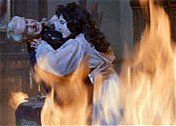 |
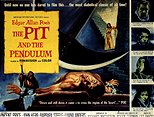 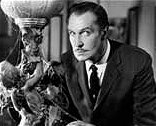 |
The
1960 release was both a critical and box office success and the next year
saw ‘The Pit and The Pendulum’ in which Vincent Price starred with Barbara
Steele. Time magazine described it as, ‘”A literary hair raiser” and
the New York Times commented, “Atmospherically, at least – there is a striking
fusion of rich colour, plushy décor and eerie music – this is probably Hollywood’s
most effective Poe-style horror flavouring to date.” ‘The Premature Burial’
in 1962 wasn’t originally to be part of the AIP series as it was due to
be distributed by another company, but AIP decided to take it up. It strayed
from the usual Corman hit formula as it wasn’t written by Matheson and it
didn’t star Price. Ray Milland appeared as a man terrified of catalepsy,
a disease which made a person seem dead and could result in them being buried
alive. The reviews weren’t as enthusiastic as those for the previous Poe
movies. Corman tried a new tack for his next Poe venture, ‘Tales of Terror’, by making an anthology film using three Poe tales, ‘Morella’, ‘The Black Cat’ and ‘The Case of M. Valdemar.’ “To break things up,” he said, “we tried introducing humour into one of them, ‘The Black Cat.’ It worked very, very well. Later, of course, we would expand the approach with ‘The Raven.’ |
| ‘Tales
of Terror’ starred Vincent Price, Basil Rathbone and Pete Lorre. ‘The Raven’
was based on Poe’s poem and starred Price, Lorre, Boris Karloff and Jack
Nicholson. It was the biggest success of the Poe pictures to date and Corman
said, “We had to play ‘The Raven’ for laughs because both Richard Matheson,
our writer and I, were getting tired of the stock Poe pictures. As it turned
out, the film was the most fun we ever had on a Poe picture.” The 1963 entry to the series was ‘The Haunted Palace’, which was actually based on the H.P. Lovecraft story ‘The Case of Charles Dexter Ward,’ using only the title of the Poe poem. It starred Price with Lon Chaney Jr and Debra Paget. Corman was unhappy that the movie was touted as a Poe film, commenting, “I fought against the title change.” The studio claimed that the film was based on a ‘story’ by Poe, although ‘The Haunted Palace’ was only a poem, and most critics regarded it as just another entry in the Poe series. Corman moved to England in 1964 to make ‘The Masque of the Red Death,’ generally acknowledged as the best film in the cycle. Based on two Poe stories, ‘The Masque of the Red Death’ and ‘Hop Toad’, it benefited from the striking cinematography of Nicholas Roeg and starred Price, Jane Asher and Hazel Court (who’d appeared in ‘The Premature Burial’ and ‘The Raven’). |
 |
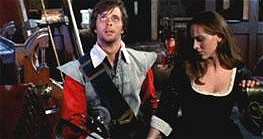 |
Corman
remained in England to film ‘The Tomb of Legeia’ and said, “This was the
last of my Poe pictures. I stopped them because I was tired of doing them.
I tried to make this last film as different from its predecessors as possible.
Robert Towne wrote it as a love story, so the script was appreciably different.
It was also the first Poe picture shot on location, outside of conventional
studios. It showed the real world, not the claustrophobic, insular world
of the older films. For the first time ever, the sun shone on the works
of Edgar Allen Poe.” AIP were later to obtain a British film, ‘The Witchfinder General,’ based on the life of witchfinder Matthew Hopkins, retitled it ‘The Conqueror Worm’ and touted it as another entry in the Poe series. Nearly two decades later, Corman returned to the Poe theme to remake ‘The Masque of the Red Death.’ also see: Sixties City: Hammer History and Films |
|
Article
|